
eBook - ePub
Basic Drawing
Louis Priscilla
This is a test
Buch teilen
- 128 Seiten
- English
- ePUB (handyfreundlich)
- Über iOS und Android verfügbar
eBook - ePub
Basic Drawing
Louis Priscilla
Angaben zum Buch
Buchvorschau
Inhaltsverzeichnis
Quellenangaben
Über dieses Buch
Unique in its presentation, Basic Drawing teaches by example. Through a profusion of self-explanatory drawings, simple rules of procedure are expertly illustrated for artists, enabling them to build a solid foundation in all aspects of art composition.
Presenting informative facts rather than ideology, the author begins with perspective and progresses to the figure in movement; light and shade; and detailed anatomy such as the head, neck, facial features, back, hips, legs, feet, arms, and hands. Using hundreds of masterful illustrations from his own portfolio, Priscilla continues with drapery, composition, and trees and landscape, including outdoor sketching. A truly all-in-one manual that belongs on every artist's bookshelf, Basic Drawing outlines the fundamental skills of drawing with an effective and powerful simplicity.
Presenting informative facts rather than ideology, the author begins with perspective and progresses to the figure in movement; light and shade; and detailed anatomy such as the head, neck, facial features, back, hips, legs, feet, arms, and hands. Using hundreds of masterful illustrations from his own portfolio, Priscilla continues with drapery, composition, and trees and landscape, including outdoor sketching. A truly all-in-one manual that belongs on every artist's bookshelf, Basic Drawing outlines the fundamental skills of drawing with an effective and powerful simplicity.
Häufig gestellte Fragen
Wie kann ich mein Abo kündigen?
Gehe einfach zum Kontobereich in den Einstellungen und klicke auf „Abo kündigen“ – ganz einfach. Nachdem du gekündigt hast, bleibt deine Mitgliedschaft für den verbleibenden Abozeitraum, den du bereits bezahlt hast, aktiv. Mehr Informationen hier.
(Wie) Kann ich Bücher herunterladen?
Derzeit stehen all unsere auf Mobilgeräte reagierenden ePub-Bücher zum Download über die App zur Verfügung. Die meisten unserer PDFs stehen ebenfalls zum Download bereit; wir arbeiten daran, auch die übrigen PDFs zum Download anzubieten, bei denen dies aktuell noch nicht möglich ist. Weitere Informationen hier.
Welcher Unterschied besteht bei den Preisen zwischen den Aboplänen?
Mit beiden Aboplänen erhältst du vollen Zugang zur Bibliothek und allen Funktionen von Perlego. Die einzigen Unterschiede bestehen im Preis und dem Abozeitraum: Mit dem Jahresabo sparst du auf 12 Monate gerechnet im Vergleich zum Monatsabo rund 30 %.
Was ist Perlego?
Wir sind ein Online-Abodienst für Lehrbücher, bei dem du für weniger als den Preis eines einzelnen Buches pro Monat Zugang zu einer ganzen Online-Bibliothek erhältst. Mit über 1 Million Büchern zu über 1.000 verschiedenen Themen haben wir bestimmt alles, was du brauchst! Weitere Informationen hier.
Unterstützt Perlego Text-zu-Sprache?
Achte auf das Symbol zum Vorlesen in deinem nächsten Buch, um zu sehen, ob du es dir auch anhören kannst. Bei diesem Tool wird dir Text laut vorgelesen, wobei der Text beim Vorlesen auch grafisch hervorgehoben wird. Du kannst das Vorlesen jederzeit anhalten, beschleunigen und verlangsamen. Weitere Informationen hier.
Ist Basic Drawing als Online-PDF/ePub verfügbar?
Ja, du hast Zugang zu Basic Drawing von Louis Priscilla im PDF- und/oder ePub-Format sowie zu anderen beliebten Büchern aus Art & Techniques d'art. Aus unserem Katalog stehen dir über 1 Million Bücher zur Verfügung.
Information
Thema
ArtThema
Techniques d'artPERSPECTIVE
Without the knowledge of perspective, constructive drawing is impossible. Leonardo Da Vinci called it the “bridle and rudder of painting.” Every form, from a grain of sand to a mountain, exists in perspective. It is the first thing a student must learn. Like the alphabet in a language, without it, one would not be able to write. Too many students by-pass this phase of learning. The knowledge of perspective makes it possible to create the illusion that objects and figures are three dimensional on a two dimensional surface such as a sheet of paper, canvas or wall.
There are three basic forms in nature: the square, the circle and the pyramid. Every object fits into these three shapes or a modification of them. The square can be a cigar box or a sky scraper, or any form with six sides. The circle or sphere can be a pea, an observation balloon or a wheel. The pyramid can be a church steeple or the pyramids of Egypt.
The muscles of the human figure can be put into any of these shapes. Knowing the names of the muscles and bones is not sufficient knowledge to draw the figure. If this were so, every good doctor would be able to draw the human figure. One must know the shape of the parts of the body and be able to put them in perspective.
The mere copying of anatomical drawings will not teach one to draw the figure or to create one without the model. There is no other field of study in which students fail in greater proportion than in art, because of by-passing the study of perspective. Its importance cannot be over-stressed. Every great painter understood its laws.
In the following pages I have. tried to show a simple approach to the subject.
With the knowledge of a few simple squares such as a radio, a match box and a package of cigarettes put together becomes a group of buildings. As shown on Page 9, Page 12 and Page 13 two photographs of a shipping department are changed into two cities. The interior of a room is nothing more than looking into a box. If one is able to draw a tube in perspective, it becomes simple to understand the foreshortening of arms and legs of the human figure.
When beginning a drawing or picture, first establish your eye level by drawing a line across your paper. It will correspond to the level of your eyes in relationship with the object or scene that you are drawing. For example, if you are sitting in a chair drawing a model who is standing in front of you, the level of your eyes will be at about the waist of the model. Every form above the eye level will recede downward to the eye level and every part of the model below the level of your eyes will extend upward to the eye level.

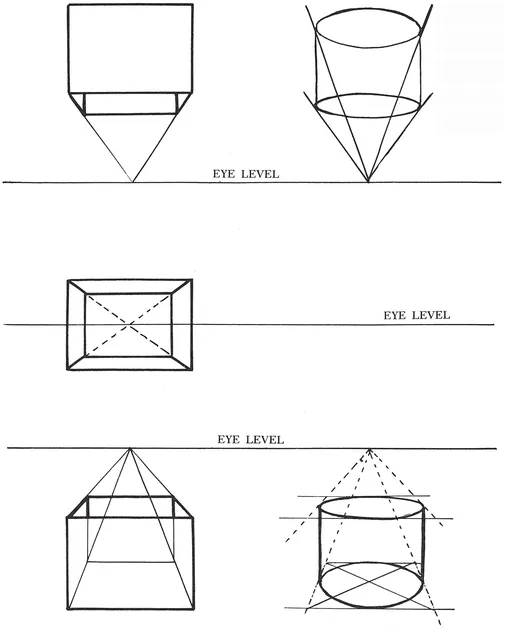
Apply these principles to any square object around you. Place a book in front of you without being able to see the sides but just the front and top and draw it using one point perspective. Try it with a table or chair or any six-sided square, then turn the same objects so you can see three sides – front, side, top using two point perspective.

All objects on this page are in two point perspective.
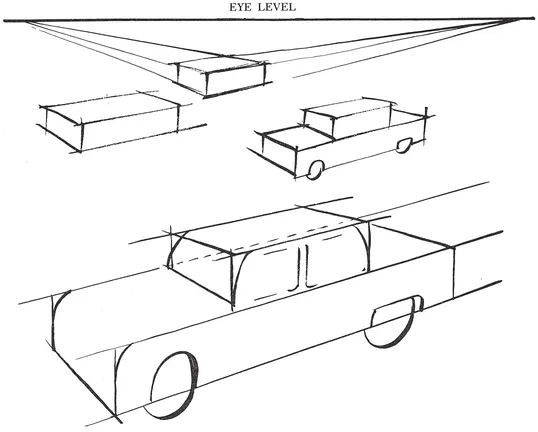
By placing one box over another and rounding the edges you have the basic perspective of a car.

SMALL BOX placed in front of long box gives you a locomotive in perspective.
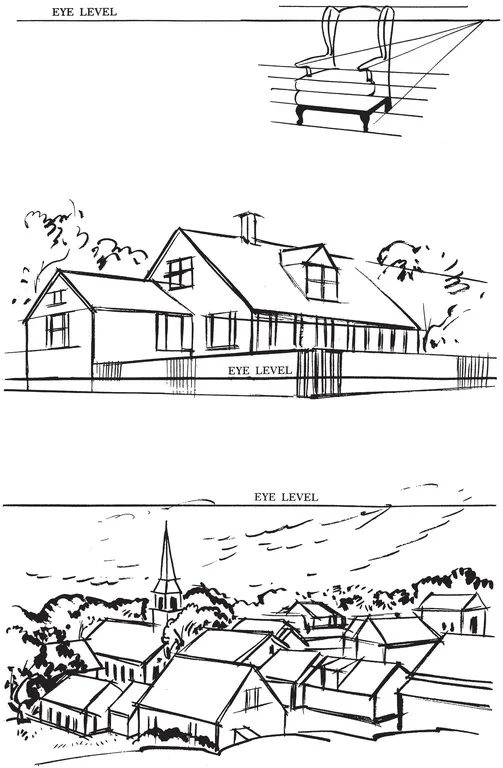
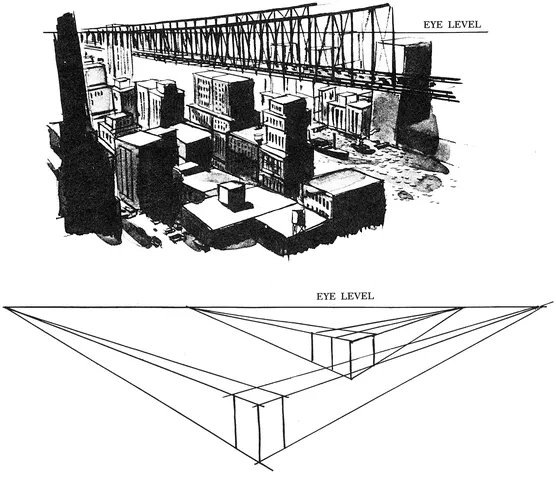
The photographs on this and the following pages are of two shipping departments filled with cartons. With the simple rule of perspective they are turned into two cities.

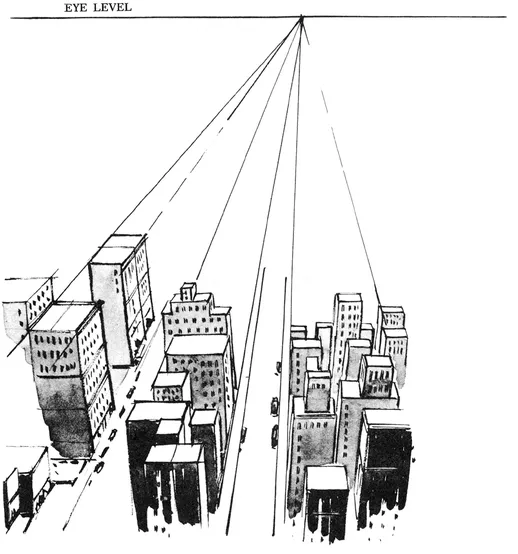

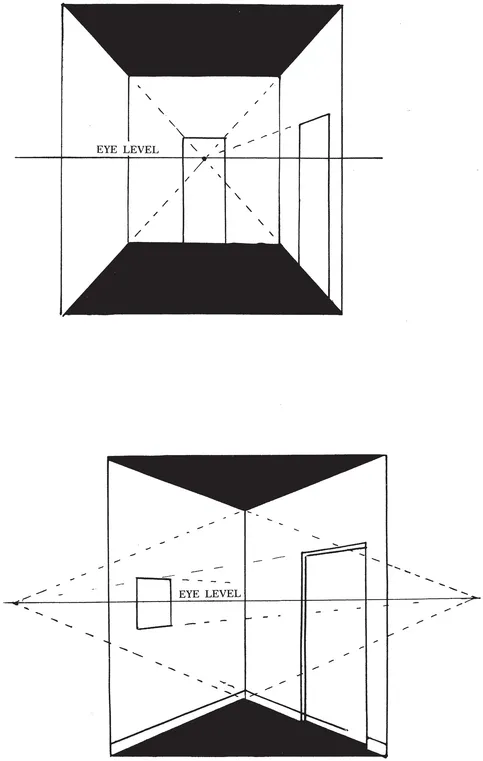
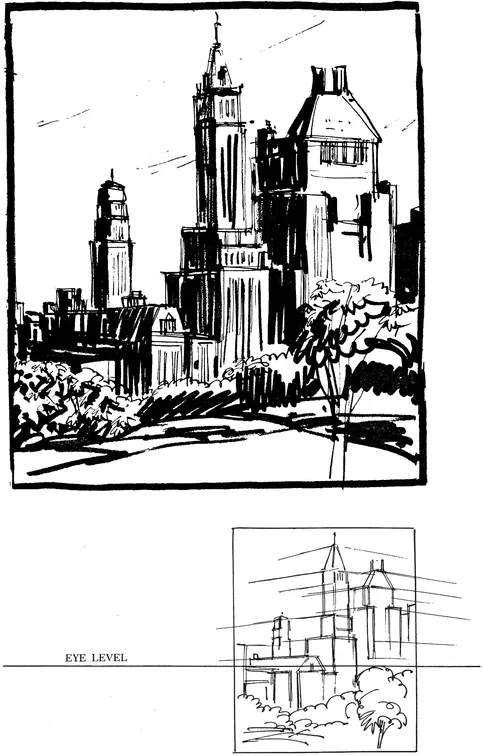
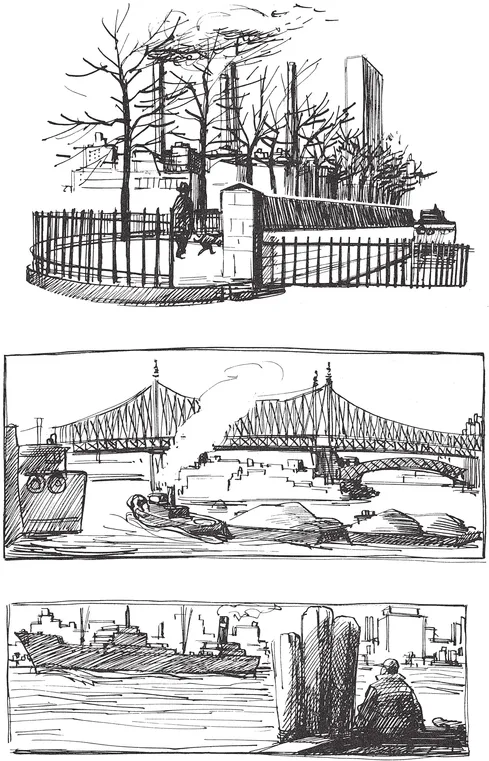
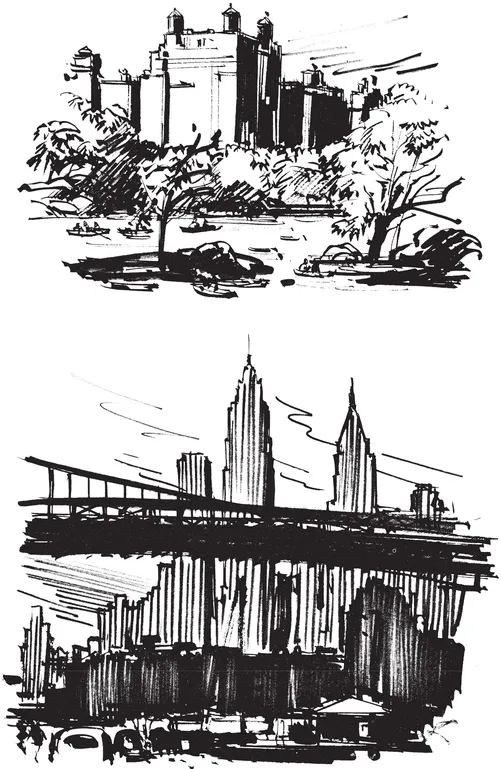
FIGURE IN PERSPECTIVE
In producing a picture with more than one figure, it is necessary to know how the figures in the background diminish in size. This is called the perspective of diminution. When you look at a string of telephone poles, the one farthest away appears smaller than the one nearest to you, even though all the poles are of the same length. Page 20 shows simple examples of how this rule of perspective is applied. On No. 1 the eye level is at the skaters’ knees. The parts of the figure that are above the eye level come down to the eye level and the parts of the figure below the eye level come to the same point on the eye level. Figures...